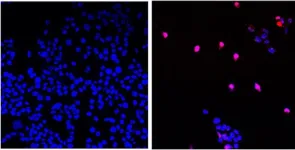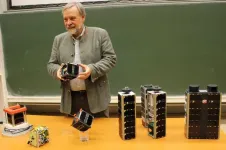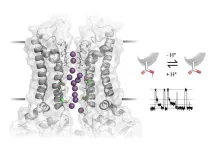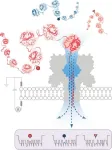(Press-News.org) LOS ANGELES — Researchers at City of Hope, one of the largest cancer research and treatment organizations in the United States, today published a new study explaining how they took a protein once thought to be too challenging for targeted therapy, proliferating cell nuclear antigen (PCNA), and developed a targeted chemotherapy that appears to annihilate all solid tumors in preclinical research. As the scientists continue to investigate the foundational mechanisms that make this cancer-stopping pill work in animal models, they note that there is an ongoing Phase 1 clinical trial testing the City of Hope-developed therapeutic in humans.
Most targeted therapies focus on a single pathway, which enables wily cancer to mutate and eventually become resistant, said Linda Malkas, Ph.D., professor in City of Hope’s Department of Molecular Diagnostics and Experimental Therapeutics and the M.T. & B.A. Ahmadinia Professor in Molecular Oncology. However, the cancer-killing pill Malkas has been developing over the past two decades, AOH1996, targets a cancerous variant of PCNA, a protein that in its mutated form is critical in DNA replication and repair of all expanding tumors.
“PCNA is like a major airline terminal hub containing multiple plane gates. Data suggests PCNA is uniquely altered in cancer cells, and this fact allowed us to design a drug that targeted only the form of PCNA in cancer cells. Our cancer-killing pill is like a snowstorm that closes a key airline hub, shutting down all flights in and out only in planes carrying cancer cells,” said Malkas, senior author of the new study published in Cell Chemical Biology today. “Results have been promising. AOH1996 can suppress tumor growth as a monotherapy or combination treatment in cell and animal models without resulting in toxicity. The investigational chemotherapeutic is currently in a Phase 1 clinical trial in humans at City of Hope.”
AOH1996 has been effective in preclinical research treating cells derived from breast, prostate, brain, ovarian, cervical, skin and lung cancers and is exclusively licensed by City of Hope to RLL, LLC, a biotechnology company that Malkas co-founded and holds financial interest in.
The researchers tested AOH1996, a small molecule PCNA inhibitor, in more than 70 cancer cell lines and several normal control cells. They found that AOH1996 selectively kills cancer cells by disrupting the normal cell reproductive cycle. It targets something called transcription replication conflicts, which occur when mechanisms responsible for gene expression and genome duplication collide. The investigational therapy prevented cells with damaged DNA from dividing in G2/M phase and from making a copy of faulty DNA in S phase. As a result, AOH1996 caused cancer cell death (apoptosis), but it did not interrupt the reproductive cycle of healthy stem cells.
“No one has ever targeted PCNA as a therapeutic because it was viewed as ‘undruggable,’ but clearly City of Hope was able to develop an investigational medicine for a challenging protein target,” said Long Gu, Ph.D., lead author of the study and an associate research professor in the Department of Molecular Diagnostics and Experimental Therapeutics at Beckman Research Institute of City of Hope. “We discovered that PCNA is one of the potential causes of increased nucleic acid replication errors in cancer cells. Now that we know the problem area and can inhibit it, we will dig deeper to understand the process to develop more personalized, targeted cancer medicines.”
Interestingly, experiments showed that the investigational pill made cancer cells more susceptible to chemical agents that cause DNA or chromosome damage, such as the chemotherapy drug cisplatin, hinting that AOH1996 could become a useful tool in combination therapies as well as for the development of new chemotherapeutics.
“City of Hope has world leaders in cancer research. They also have the infrastructure to drive translational drug discovery from the laboratory into the clinic for patients in need,” said Daniel Von Hoff, M.D., study co-author and a distinguished professor at Translational Genomics Research Institute, part of City of Hope.
City of Hope’s groundbreaking translational research history includes developing the technology underlying synthetic human insulin, a breakthrough in diabetes management, and monoclonal antibodies, which are integral to widely used, lifesaving cancer drugs, such as trastuzumab, rituximab and cetuximab.
As a next step, the researchers will look to better understand the mechanism of action to further improve the ongoing clinical trial in humans. Individuals interested in the Phase 1 clinical trial should review the eligibility requirements at clinicaltrials.gov. If eligible, call 626-218-1133 or visit City of Hope’s clinical trials webpage.
# # #
The Cell Chemical Biology study entitled “Small Molecule Targeting of Transcription-Replication Conflict for Selective Chemotherapy” was supported by the Department of Defense (W81XWH-11-1-0786, W81XWH-19-1-0326 under BC181474 and BC181474P1), National Institutes of Health/National Cancer Institute (R01 CA121289, R01 CA225843), St Baldrick's Foundation, the Alex Lemonade Stand Foundation, Tobacco-Related Disease Research Program (TRDRP-T31IP626), Melanoma Research Foundation (MRF-717178), the ANNA Fund, RDL Foundation, Analytical Pharmacology Core supported by the National Cancer Institute of the National Institutes of Health (P30CA033572).
About City of Hope
City of Hope's mission is to deliver the cures of tomorrow to the people who need them today. Founded in 1913, City of Hope has grown into one of the largest cancer research and treatment organizations in the U.S. and one of the leading research centers for diabetes and other life-threatening illnesses. City of Hope research has been the basis for numerous breakthrough cancer medicines, as well as human synthetic insulin and monoclonal antibodies. With an independent, National Cancer Institute-designated comprehensive cancer center at its core, City of Hope brings a uniquely integrated model to patients spanning cancer care, research and development, academics and training, and innovation initiatives. City of Hope’s growing national system includes its Los Angeles campus, a network of clinical care locations across Southern California, a new cancer center in Orange County, California, and treatment facilities in Atlanta, Chicago and Phoenix. City of Hope’s affiliated group of organizations includes Translational Genomics Research Institute and AccessHopeTM. For more information about City of Hope, follow us on Facebook, Twitter, YouTube, Instagram and LinkedIn.
END
Millions of Americans with tobacco-related lung disease have symptoms that do not fit any existing tobacco-related disease criteria – including the most common of those, chronic obstructive pulmonary disease (COPD) – according to a new study led by researchers at UC San Francisco.
In a study publishing Aug. 1, 2023, in the Journal of the American Medical Association (JAMA), the research team found that half of the participants with extensive tobacco exposure had a persistently high level of respiratory symptoms, including shortness of breath, daily cough and ...
Para-cresol is an aromatic compound with a strong horse stable-like odor. It contributes to the off-flavor of some foods, but it is also detectable as a characteristic odorant in whiskey and tobacco, as well as in the urine of various mammals. A research team led by the Leibniz Institute of Food Systems Biology at the Technical University of Munich has now discovered which odorant receptor humans use to perceive para-cresol.
Para-cresol (4-methylphenol) is formed during the microbial degradation of certain amino acids, but also during thermal ...
A large natural experiment in Catalonia shows that moving to areas with higher levels of air pollution is associated with weight gain in young children. The study, led by the Barcelona Institute for Global Health (ISGlobal), an institution supported by ”la Caixa Foundation”, in collaboration with the IDIAP Jordi Gol, provides further evidence to support efforts to reduce air pollution.
Overweight and obesity in childhood result from the interaction of genes, lifestyle behaviours, physiological and social factors. Environmental exposures such as air pollution may ...
Aug. 1, 2023
Contact: Derek Smith, 734-546-3632, smitdere@umich.edu
Katherine McAlpine, 734-647-7087, kmca@umich.edu
Images
Cracking in lithium-ion batteries speeds up electric vehicle charging
Cracks in predominant lithium-ion electrodes shorten battery lifespans, but a neuroscience-inspired technique shows that they have an upside
ANN ARBOR—Rather than being solely detrimental, cracks in the positive electrode of lithium-ion batteries reduce battery charge time, research done at the University of Michigan shows.
This runs counter to the view of many ...
INDIANAPOLIS – Periodontal disease is a growing public health issue in the United States as the nation’s population ages, yet it’s underdiagnosed and undertreated. According to the U.S. Centers for Disease Control and Prevention (CDC), 47 percent of adults aged 30 years and older and 79 percent of adults 65 years and older have some form of periodontal disease.
Researchers from Regenstrief Institute and Indiana University School of Dentistry have developed computer algorithms to track periodontal disease change, which could help dentists and periodontists follow disease progression. They also have developed tools to ...
The International Astronautical Federation (IAF) selected Würzburg space expert Professor Klaus Schilling for the Frank J. Malina Astronautics Medal 2023. This medal is a top award in the space sector for innovative research and for commitment to education.
According to a statement by the IAF, the medal is awarded each year to a personality who has provided outstanding services to space education and research. This applies to Professor Schilling without reservation: "He has provided numerous students with practical experience in satellite construction and has been involved in a wide ...
Ion channels play a crucial role in many cellular processes, including neuronal communication, muscle contraction or cell proliferation. Most multi subunit ion channels exist in two functional states, either closed or open. During gating, one should expect that all subunits undergo conformational changes. The absence of intermediate conduction levels is surprising and asks for an explanation. A team of researchers from the University of Vienna and the Washington University in St. Louis created a smart model system to answer this important question. The study is currently published in Nature ...
A new type of analysis of a spectacular 120-million-year-old fossil skeleton of the extinct early bird Jeholornis from northeastern China has revealed the oldest evidence for birds eating leaves, marking the earliest known evolution of arboreal plant-eating among birds.
The pheasant-sized Jeholornis, a member of the second most primitive lineage of known birds, has teeth and a long bony tail like its predatory, feathered dinosaur relatives. However, microscopic analysis of the fossilized residues in the stomach of this juvenile, arboreal (tree-living) bird demonstrates that Jeholornis was not a predator. It had eaten tree leaves from a group ...
Scientists have developed a breakthrough method to detect structural variations on proteins based on nanopore technologies.
Protein chains are fed through an engineered nanopore, with subtle variations in structure detected through the modulation of tiny electrical currents.
The method could transform our understanding of how protein variants are associated with diseases, and allow point-of-care diagnostics.
A team of scientists led by the University of Oxford have achieved a significant breakthrough in detecting modifications on protein structures. The method, published in Nature Nanotechnology, employs innovative nanopore technology to identify structural ...
When you need accurate information about a serious illness, should you go to Google or ChatGPT?
An interdisciplinary study led by University of California, Riverside, computer scientists found that both internet information gathering services have strengths and weaknesses for people seeking information about Alzheimer's disease and other forms of dementia. The team included clinical scientists from the University of Alabama and Florida International University.
Google provides the most current information, but query results are skewed by service and product providers seeking customers, the researchers found. ChatGPT, meanwhile, ...






